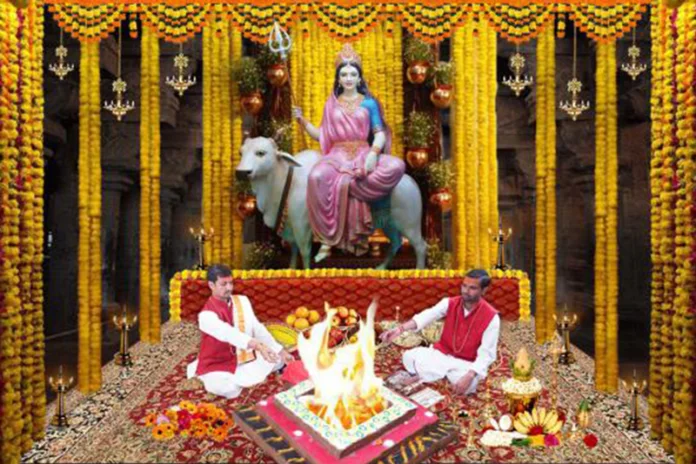
In the vast pantheon of Hindu mythology, Maa Shailputri stands tall as one of the most revered forms of Goddess Durga. As the auspicious occasion of Navratri dawns, devotees across the globe prepare to pay homage to this divine manifestation on the first day of the festival. The name ‘Shailputri’ itself carries profound significance, derived from the Sanskrit words ‘Shail’ meaning mountains and ‘Putri’ meaning daughter, symbolizing her as the daughter of the mountains.
The Origin Story
Legend has it that Maa Shailputri was born as the daughter of the King of Mountains, Parvat Raj Himalaya. She is also known by various other names such as Sati Bhavani, Parvati, or Hemavati, emphasizing her divine lineage and connection to the Himalayas. In her previous birth, she was named Sati and was the daughter of King Daksha. Despite opposition from her father, she chose to marry Lord Shiva. This act of defiance led to her father’s resentment, eventually culminating in a tragic turn of events where Sati sacrificed herself in the fire of a yagna organized by her father.
Iconography and Symbolism
Depicted with a serene countenance, Maa Shailputri is often portrayed seated on a Nandi, the sacred bull. Adorned with a crescent moon on her forehead, she holds a trident (trishul) in her right hand and a lotus flower in her left. Each element of her iconography carries symbolic significance, representing attributes of strength, purity, and grace.
Rituals and Worship
The first day of Navratri marks the initiation of the worship of Maa Shailputri, with the ritual of ‘Ghatasthapana’ being central to the proceedings. This ritual involves the installation of an earthen pot filled with soil and grains, symbolizing the manifestation of Mother Nature. Devotees invoke Goddess Durga in the form of Shailputri, reciting sacred mantras and performing elaborate puja ceremonies to seek her blessings.
Significance and Benefits
The worship of Maa Shailputri is believed to bestow numerous blessings upon devotees. From warding off malefic influences to fostering peace, harmony, and overall happiness, her divine grace is said to encompass all aspects of life. Additionally, the puja is believed to strengthen marital bonds, offer stability in career and business endeavors, and keep diseases and negative energies at bay.
Mantras and Devotional Hymns
Devotees chant sacred mantras and hymns dedicated to Maa Shailputri, seeking her divine blessings and guidance. These invocations not only express reverence but also serve as a means of connecting with the divine presence of the Goddess.
As Navratri approaches, let us immerse ourselves in the devotion and reverence for Maa Shailputri, embracing her divine essence and seeking her blessings for a life filled with strength, prosperity, and spiritual fulfillment.

